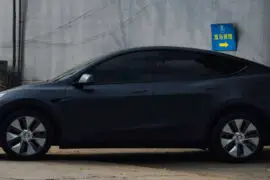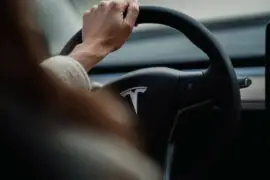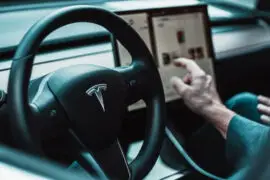Last Updated on July 5, 2024 by Rose Morah
Electric vehicles (EVs) lose their battery capacity over time. This process is known as battery degradation.
Battery degradation happens in two ways:
- With time (cyclic aging).
- From use (calendar aging).
There are several factors that affect the age of the battery (its longevity).
Some of these factors are related to environmental conditions, such as humidity and temperature.
If you are wondering how many miles a Tesla battery lasts or when to replace the battery after buying a new Tesla, this article offers a complete guide to that and all that you need to know about Tesla battery degradation.
Related: How To Check Tesla Battery Health/Battery Degradation.
How long does a tesla battery last before replacement?
There is no exact Tesla battery lifespan. However, according to Elon Musk’s tweet, a Tesla battery should last between 300,000 miles (480, 000 km) to 500,000 miles (800,000 km).
Additionally, some Tesla owners experience battery degradation far much quicker than others and vice versa.
| NOTE: 1. Battery degradation may still occur even when you haven’t driven for many miles. This is because of cyclic aging. 2. Tesla battery is made of hundreds if not thousands of small cells(battery pack). This means that if an individual cell wears out prematurely, you will still get power from the battery pack. |
Related:
Tesla Battery Replacement Cost (How Much It Will It Cost You).
Does Tesla Autopilot Use More Battery?
Below is Elon Musk’s tweet
Model 3 drive unit & body is designed like a commercial truck for a million mile life. Current battery modules should last 300k to 500k miles (1500 cycles). Replacing modules (not pack) will only cost $5k to $7k.
— Elon Musk (@elonmusk) April 13, 2019
Tesla batteries are lasting much longer than 200k miles / 320k km pic.twitter.com/z882nf6yv9
— Elon Musk (@elonmusk) June 10, 2020
Related: Prius Battery Lifespan: How Long Does Toyota Prius Battery Last.
Battery degradation data from Tesla owners
To get a better idea of the percentage of battery degradation experienced by Tesla owners, we collected data from over 300 Tesla owners submitted through an online survey.
NOTE: For quality purposes, we requested the participants to submit the % of battery degradation as well as the method used to determine their results.
This is because some Tesla owners use inaccurate methods to determine their battery degradation.
This data was collected from the US and UK Tesla owners.
The table below shows the feedback data that was collected:
| % of Tesla Owners & Battery Degradation | Years of Ownership |
| 88% lost 5% | The first 2 years |
| 12% lost over 5% | The first 2 years |
| 86% lost up to 10% | After 5 to 8 years |
| 60% lost over 10% | After the 8-year mark |
| 80% lost more than 15% | After 10 years |
| Miles Covered | % of Tesla Owners & % of Battery Degradation |
| <10,000 | 2% lost more than 10 % (There was one owner who reported 90% battery degradation). |
| 10,000 – 50,000 | 60% lost less than 7% 40% lost over 7 % |
| 50,000 – 100,000 | 80% lost less than 10% 20% lost over 10% |
| 100,000 – 150,000 | Out of 5 owners who had covered these miles; 3 reported 0% battery degradation. 1 reported 25% battery degradation. 1 reported 12% battery degradation. |
| 150,000 – 200,000 | (No data) |
| 200,000 – 250,000 | (No data) |
| 250,000 – 300,000 | (No data) |
| 250,000 – 350,000 | Out of 11 owners who had covered these miles; 2 reported 2% battery degradation. 5 reported 20% battery degradation. 3 reported 15% battery degradation. 1 reported severe 90% battery degradation. |
You might also like:
How To Finance a Tesla (Tips and Tricks).
Complete Guide To Buying A Tesla (What to Know Before Ordering A Tesla).
31 Cool Tesla Voice Commands 2022.
Summary of the feedback
Based on the above data:
- We noted that most Tesla owners experience the highest battery degradation during the first year of owning a Tesla and later slows down over time.
After we reached out to experts in the industry, they all confirmed this to be normal and to be expected on lithium-ion EV batteries.
- We noted that the level of battery degradation varies depending on the Tesla Models.
Most Tesla owners who own more than one Tesla have seen a higher battery degradation on one Model compared to the other.
For instance, my model Y which I bought after my model 3 has 13% degradation after 50,000 miles. On the other hand, the Model 3 is at 5% degradation after 80,000 miles.
See also:
How To Use The Tesla Energy App (Complete Guide With Pictures).
Tesla Model Comparison: Which Tesla Should You Buy?
What are the effects of Tesla battery degradation?
There are many effects of battery degradation. However, the 2 main effects that you should look out for are;
- You start to experience range drop.
- The car starts to charge slower.
You may also like the Pros and Cons Of Owning A Tesla.
When should you replace your Tesla Battery?
If you are getting a very low consistent range from your Tesla, I recommend calling Tesla. They will schedule a battery inspection and advise if it needs to be replaced.
Tesla warranty for battery and drive unit is covered for the following period of time;
- 8 years or 120,000 miles (minimum 70% retention of the battery capacity) for both Model 3 and Y Performance and Long Range.
- 8 years or 100,000 miles (minimum 70% retention of the battery capacity) for both Model 3 Rear-Wheel Drive.
- 8 years or 150,000 miles (minimum 70% retention of the battery capacity) for both Model X and S.
You may also like:
Is Tesla Wall Connector Worth It? (Pros & Cons).
Tesla Wall Connector VS Mobile Connector.
How to prevent Tesla battery from degrading faster
- Do not over-rely on charging at Superchargers on a daily basis.
Tesla tends to lay more focus on keeping their batteries to optimum conditions so that when you are fast charging the battery will not be majorly affected.
However, you still need to take precautions when fast charging because when done every day it may prematurely age the battery.
This is because, whenever you fast charge your Tesla, you are exposing it to more heat due to the high state of charge which causes more stress in the battery pack cells.
This in turn reduces the cells’ life span.
- Charge your Tesla regularly
Tesla recommends that you leave the car plugged in when parked or when you are not using it.
- Tesla’s battery type.
According to Tesla, people who own the most recent Tesla can charge up to 100%. This is unlike the older Tesla where the recommended charge is at least 80%.
This means that if your Tesla has a Lithium Iron Phosphate (LFP) battery (the most recent Tesla battery technology as of now) the recommended capacity is 100%.
Additionally, Tesla recommends charging up to 100% at least once a week.
See also:
4 Ways To Reboot Your Tesla To Help Fix Issues (Soft & Hard Reset).
Are Tesla Wheel Locks Worth It?
How do you know whether your Tesla has a Lithium Iron Phosphate battery?
Follow the below steps:
- On your Tesla screen navigation, open the charge option.
- Tap the “Set Limit”.
- Then check if the battery’s image shows “50%” and “100%” or “Daily” and “Trip”.
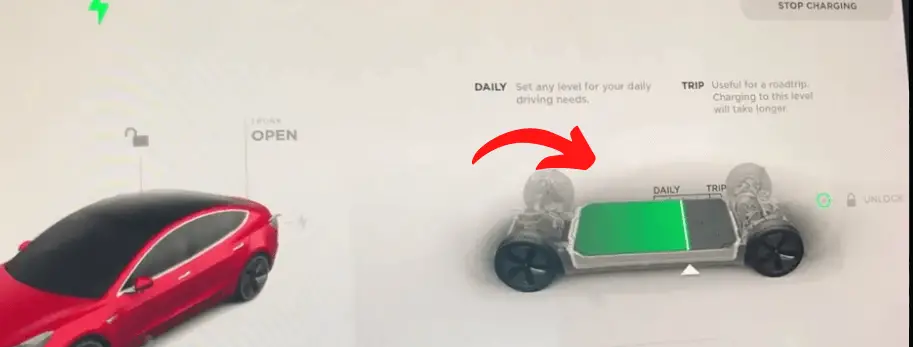
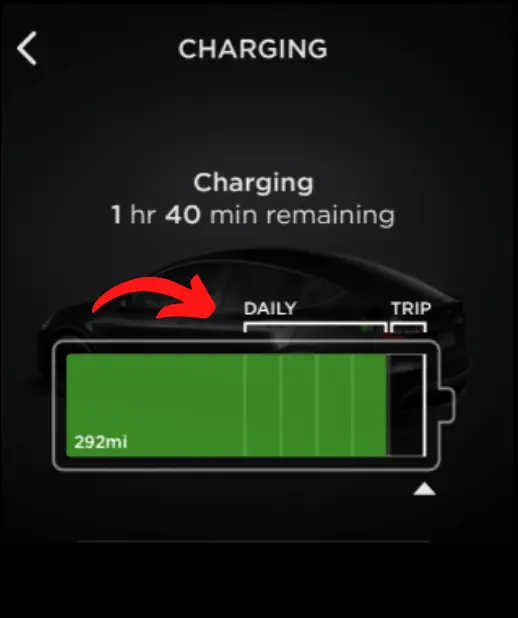
If it reads “Daily” and “Trip” this means that your Tesla does not have the Lithium Iron Phosphate (LFP) battery.
If it shows “50%” and “100%” this means that it has the LFP battery.
Though you can still charge your Tesla to 100% even if you do not have an LFP battery, Tesla advises that you avoid doing it frequently.
They suggest you only do this occasionally when you really need to, especially on long road trips.
You may also like: How Long Does A Toyota Hybrid Battery Last?
- Do not let your Tesla discharge to 0%
Tesla discourages owners from letting the battery lose charge to 0%.
This not only affects the battery but may also damage other components in the car.
This is because Tesla will need to use energy periodically even when the car is not in use. For instance, to conduct some system tests and recharge the battery.
- Do not expose your Tesla to very high or low temperatures.
For example, if you live in very hot areas, leaving your Tesla parked the whole day in the direct sun leads to battery degradation.
“Look after your battery and it will also look after you”
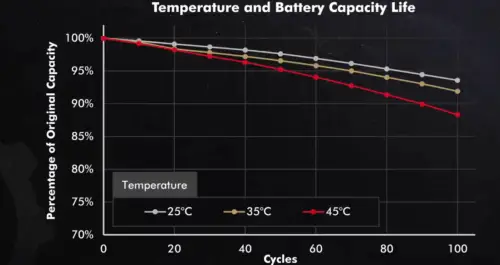
| NOTE: Cold weather temporarily reduces the battery capacity. Hence, during the cold winter seasons, most Tesla owners tend to think that their batteries are degrading. But in most cases, the battery capacity reduction is due to the low temperatures. |


